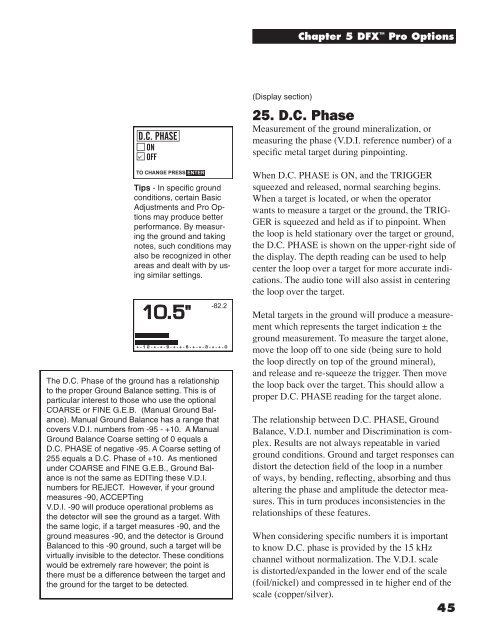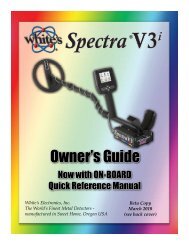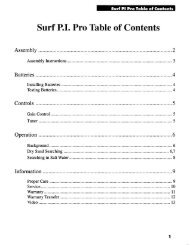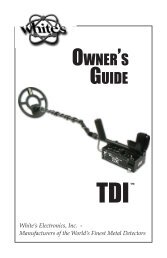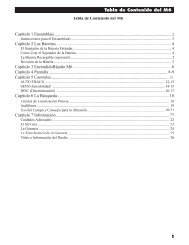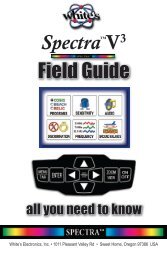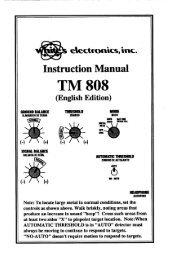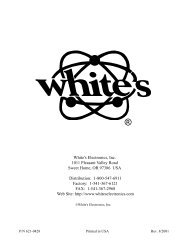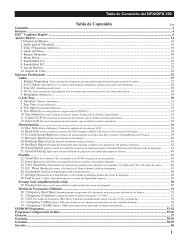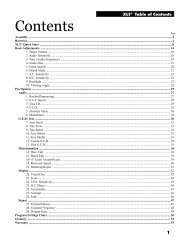DFX 300 Manual - White's Metal Detectors
DFX 300 Manual - White's Metal Detectors
DFX 300 Manual - White's Metal Detectors
You also want an ePaper? Increase the reach of your titles
YUMPU automatically turns print PDFs into web optimized ePapers that Google loves.
Tips - In specifi c ground<br />
conditions, certain Basic<br />
Adjustments and Pro Options<br />
may produce better<br />
performance. By measuring<br />
the ground and taking<br />
notes, such conditions may<br />
also be recognized in other<br />
areas and dealt with by using<br />
similar settings.<br />
The D.C. Phase of the ground has a relationship<br />
to the proper Ground Balance setting. This is of<br />
particular interest to those who use the optional<br />
COARSE or FINE G.E.B. (<strong>Manual</strong> Ground Balance).<br />
<strong>Manual</strong> Ground Balance has a range that<br />
covers V.D.I. numbers from -95 - +10. A <strong>Manual</strong><br />
Ground Balance Coarse setting of 0 equals a<br />
D.C. PHASE of negative -95. A Coarse setting of<br />
255 equals a D.C. Phase of +10. As mentioned<br />
under COARSE and FINE G.E.B., Ground Balance<br />
is not the same as EDITing these V.D.I.<br />
numbers for REJECT. However, if your ground<br />
measures -90, ACCEPTing<br />
V.D.I. -90 will produce operational problems as<br />
the detector will see the ground as a target. With<br />
the same logic, if a target measures -90, and the<br />
ground measures -90, and the detector is Ground<br />
Balanced to this -90 ground, such a target will be<br />
virtually invisible to the detector. These conditions<br />
would be extremely rare however; the point is<br />
there must be a difference between the target and<br />
the ground for the target to be detected.<br />
(Display section)<br />
Chapter 5 <strong>DFX</strong> Pro Options<br />
25. D.C. Phase<br />
Measurement of the ground mineralization, or<br />
measuring the phase (V.D.I. reference number) of a<br />
specifi c metal target during pinpointing.<br />
When D.C. PHASE is ON, and the TRIGGER<br />
squeezed and released, normal searching begins.<br />
When a target is located, or when the operator<br />
wants to measure a target or the ground, the TRIG-<br />
GER is squeezed and held as if to pinpoint. When<br />
the loop is held stationary over the target or ground,<br />
the D.C. PHASE is shown on the upper-right side of<br />
the display. The depth reading can be used to help<br />
center the loop over a target for more accurate indications.<br />
The audio tone will also assist in centering<br />
the loop over the target.<br />
<strong>Metal</strong> targets in the ground will produce a measurement<br />
which represents the target indication ± the<br />
ground measurement. To measure the target alone,<br />
move the loop off to one side (being sure to hold<br />
the loop directly on top of the ground mineral),<br />
and release and re-squeeze the trigger. Then move<br />
the loop back over the target. This should allow a<br />
proper D.C. PHASE reading for the target alone.<br />
The relationship between D.C. PHASE, Ground<br />
Balance, V.D.I. number and Discrimination is complex.<br />
Results are not always repeatable in varied<br />
ground conditions. Ground and target responses can<br />
distort the detection fi eld of the loop in a number<br />
of ways, by bending, refl ecting, absorbing and thus<br />
altering the phase and amplitude the detector measures.<br />
This in turn produces inconsistencies in the<br />
relationships of these features.<br />
When considering specifi c numbers it is important<br />
to know D.C. phase is provided by the 15 kHz<br />
channel without normalization. The V.D.I. scale<br />
is distorted/expanded in the lower end of the scale<br />
(foil/nickel) and compressed in te higher end of the<br />
scale (copper/silver).<br />
45


